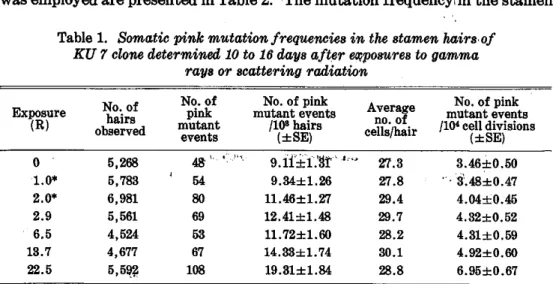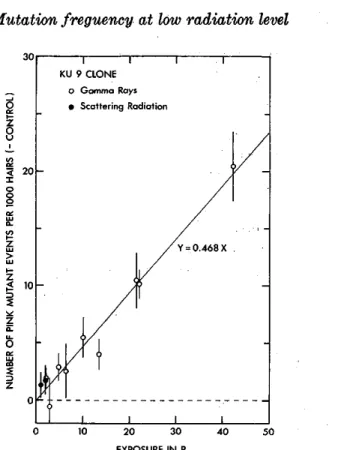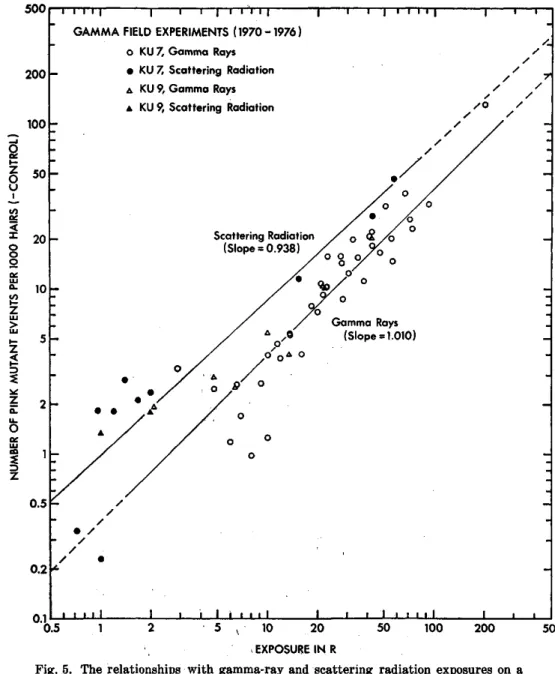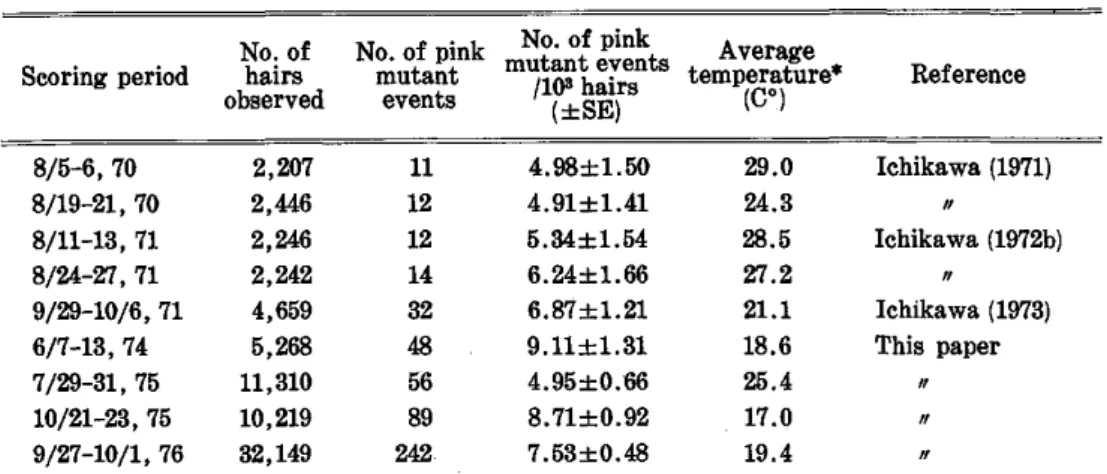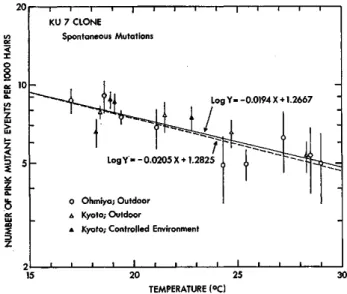Jpn. J. Genet. (1981) 56, pp. 409-423
Somatic mutation frequency in the stamen hairs of T radescantia KU 7 and KU 9 clones exposed
to low-level gamma rays')
BY Sadao ICHIKAWA, Catarina S. TAKAHASHI*2) and Chizu NAGASHIMA-ISHII
Laboratory of Genetics, Department of Regulation Biology, Faculty of Science, Saitama University, Urawa 338
and
*Faculdade de Filosofia , Ciencias e Letras, Universidade de Sao Paulo, 14100 Ribeirao Preto, Sao Paulo, Brazil
(Received January 26, 1981)
ABSTRACT
Two triploid clones (KU 7 and KU 9) of Tradescantia heterozygous for flower color were exposed to 1 to 42.3 R of gamma rays or the scattering radiation in the gamma field of the Institute of Radiation . Breeding. Oc- currence of somatic pink mutations in the stamen hairs was investigated 10 to 16 (or 14) days after irradiation. The mutation frequency was found to increase linearly with increasing gamma-ray exposure in the both clones, and the frequencies of 0.437 and 0.468 pink mutant events per 103 hairs per R were determined for KU 7 and KU 9, respectively. When the data collected in the present study were analyzed together with those obtained in earlier experiments in the gamma field, linear relationships of the somatic mutation frequency with gamma-ray (2.1 to 201.6 R) and scattering radiation (0.72 to 57.6 R) exposures were confirmed. Scattering radiation was found to have a genetical efficiency more than two times higher than that of gamma rays.
Variation of spontaneous mutation frequency observed in the present study and in earlier studies was inversely correlated to temperature variation.
1. INTRODUCTION
While the risk estimate of low-level ionizing radiations has been . regarded as an urgent problem to be solved (see BEIR Reports 1972, 1980), the genetic effect at low-dose levels has been relatively well studied with higher plants rather than with animals and microorganisms. This is because two botanical systems, Tradescantia stamen hairs heterozygous for flower color (see Under- brink et al. 1973; Ichikawa 1974) and cereal pollen grains possessing suitable
1) The research was supported by the grant from the Ministry of Education, Science and Cul- ture for the co-operative utilization of the Institute of Radiation Breeding, NIAS, Ministry of Agriculture, Forestry and Fishery, and also partly by the Grants-in-Aid for Scientific Research (Nos. 958034 and 036002) from the Ministry of Education, Science and Culture, and was carried out when the authors were working at the Laboratory of Genetics, Faculty of Agriculture, Kyoto University.
2) Visiting Researcher to the Laboratory of Genetics, Faculty of Agriculture, Kyoto Univer-
sity, supported by the Fundacao de Amparo a Pesquisa de Estado de Sao Paulo (FAPESP), Brazil.
410 S. ICHIKAWA, C. S. TAKAHASHI AND C, NAGASHIMA-ISHII
starch characters (see de Nettancourt et al.1977), have been proved to be most excellent test systems for such studies. In particular, the characteristics of Tradescantia stamen-hair system, that is, the capability of detecting all pink mutant cells easily without being concealed by other cells as well as the rela- tive easiness of handling a great number of samples, have proved to be es- pecially suitable for studying the genetic effect of low-level radiations (Under- brink et al. 1973; Ichikawa 1974, 1976,1981b).
In fact, Ichikawa (1971,1972b) demonstrated that the somatic pink mutation frequency in the stamen hairs of Tradescantia KU 7 clone kept a linear relationship with chronic gamma-ray exposure down to 8.0 R, after repeating experiments in the gamma field of the Institute of Radiation Breeding, Ohmiya, Ibaraki. He also reported a higher genetic efficiency of scattering radiation in the gamma field at low-exposure levels such as down to 0.96 R. Sparrow et al.
(1972) demonstrated further that the somatic pink mutation frequency in Tradescantia clone 02 stamen hairs increased linearly with increasing acute X-ray dose in the extremely small-dose range of 0.25 to 6 rad and that the mutation frequency with 0.43-MeV neutrons was linear down to 0.01 rad.
Ichikawa and Takahashi (1977) also confirmed such linear relationships between acute gamma-ray exposure (3.1 to 50.8 R) and somatic mutation frequency in the stamen hairs of KU 9 and KU 20 clones of Tradescantia, and Ichikawa et al.
(1978) reported that the somatic mutation frequency in clone 02 stamen hairs was linear when` exposed to gamma rays at lower exposure rates such as 0.026 to 0.52 R/min.
Furthermore, the genetic effects of relatively high natural background radi- ation levels have been detected with the stamen-hair system of Tradescantia (Mericle and Mericle 1965; ;Nayar et al. 1970), as well as the significance of internal exposures from 3H (Nauman et al. 1979) and 1311 (Tano and Yamaguchi 1979) at low levels. Increased somatic mutation frequencies in the stamen hairs have been also reported by growing Tradescantia in soil samples from the Bikini Island (Ichikawa and Nagashima 1979) or near nuclear facilities (Ichikawa 1981a). Comparable findings obtained from other organisms are only those of • the cytological effects of higher natural radiation levels detected in the root-tip cells of some plant species (Gopal-Ayengar et. al. 1970) and in the spermatocytes of scorpions (Takahashi 1976).
The present paper describes the 'results of further experiments w4th Trades- cantia performed in the gamma field of the Institute' of Radiation Breeding, and discusses about inf ormations accumulated through a series of such experi-
ments.
2. MATERIALS AND METHODS
The materials used were two triploid clones (2n =18)t of Tradescantia ,, KU 7
and KU 9, both heterozygous for, flower,, and stamen color (blue/pink; the blue
Mutation f reguency at low radiation level 411
color being dominant). The KU 7 clone of T. ohiensis Raf. (= T. reflexa Raf.) has been described to be a tetraploid (Ichikawa 1970, 1971,1972b, 1974; Taka- hashi and Ichikawa 1976) but is noted here as a triploid, since our recent chromosome counts on the stock plants as well as on the materials used in the present and other studies have proved that all of those examined cytologically have 18 chromosomes (Ichikawa 1981a). The morphological characteristics, of this clone are, however, essentially unchanged from those described earlier
(Ichikawa 1970, 1974). The KU 9 is a hybrid clone between T. ohiensis and T.
paludosa And. et Woods. as reported earlier (Ichikawa 1972a). The both clones are vigorous in growth and are sterile because of their triploid nature, being suitable materials for outdoor experiments. All the plants used were those propagated vegetatively from the stock clones, and were grown in 24 cm clay pots.
Irradiation treatments were performed in the gamma field of the Institute of Radiation Breeding. In the first experiment, potted plants of KU 7 clone having young inflorescences of flowering size were placed on May 28, 1974, at five different points in the gamma field, i.e.,100, 70, 50 and 40 m apart from the 60Co source and 40 m apart but behind an earth bank built in the gamma field to shield from direct gamma rays. The plants were removed from the
gamma field on the next day, except a part of the plants placed behind the earth bank, which were removed one more day later. These plants were thus exposed to 2.9, 6.5, 13.7 and 22.5 R of gamma rays (plus scattering radiation) and to 1.0 and 2.0 R of scattering radiation only. All these exposure data and also those described below are based on the dosimetry made by the personnel of the institute with thermo-luminescence dosimeters. The control plants were placed in a control field (ca. 640 m apart from the center of the gamma field;
ca. 0.05 mR/hr radiation level) of the institute. The irradiated and ° control plants were carried back to Kyoto University, and mutation data were collected 10 to 16 days after irradiation.
The second irradiation experiment was carried out with KU 9 clone on August 5, 1974, following the same procedures as described above, and the potted plants were exposed to 2.9, 6.4, 13.5 and 22.2 R of gamma rays (plus scattering radiation) and to 1.0 and 2.0 R of scattering radiation.
In the third irradiation experiment which was carried out on September 17,
1976, both KU 7 and KU 9 clones were employed. Potted plants were placed
at five different points in the gamma field, i.e.,100, 70, 50, 35 and 25 m apart
from the s°Co source, and were removed on the next day. With such overnight
(20-hr) treatments, the plants of both clones were exposed to 2.1, 4.8, 10.1, 21.6
and 42.3 R of gamma rays (plus scattering radiation). In this experiment, the
irradiated and control plants were not carried back to Kyoto, but were left in
the control field after treatments. Thus the mutation scoring was made at
Ohmiya 10 to 14 days after irradiation.
412 S. ICHIKAWA, C. S. TAKAHASHI AND C. NAGASHIMA-ISHII
For collecting mutation data, occurrence of somatic mutations from blue to pink in stamen hairs was recorded regarding a single pink cell or two or more contiguous pink cells as one pink mutant event (see Ichikawa and Sparrow 1968; Ichikawa et al. 1969) . The number of stamen hairs was counted on each stamen (each flower has three antipetalous and three antisepalous stamens) to determine mutation frequency per hair, and the number of hair cells was also counted on ten representative hairs (distal three, middle four and basal three hairs) each of one antipetalous and one antisepalous stamens per flower (see Ichikawa and Takahashi 1978) in order to obtain mutation frequency per cell division.
Besides the above irradiation experiments, spontaneous somatic pink mu- tation frequency in stamen hairs was examined in late July and late October of 1975 for the KU 7 plants which had been kept in the control field of the Institute of Radiation Breeding since May, 1970, in order to know the variation of spontaneous mutation frequency level.
3. RESULTS
The data obtained from the first experiment with KU 7 clone are presented in Table 1. The mutation frequency in the control plants, 9.11 ± 1.31 pink mutant events per 103 hairs, was much higher than those determined as control levels in earlier experiments in the gamma field (4.91 ± 1.41 to 6.87 ± 1.21 pink mutant events per 103 hairs; see Table 5), but it was apparently observed that the mutation frequency per 103 hairs tended to increase more with higher exposures. Similar increases are also seen for the mutation frequency ex- pressed as the number of pink mutant events per 104 hair-cell divisions.
The mutation data collected in the second experiment in which KU 9 clone was employed are presented in Table 2. The mutation frequency ~ in the stamen
Table 1. Somatic pink mutation frequencies in the stamen hairs of KU 7 clone determined 10 to 16 days after exposures to gamma
rays or scattering radiation
* Exposure to scattering radiation . Other exposures are those to gamma rays.
Mutation _frequency at low radiation level 413
hairs of control plants was reasonably low being 3.00±0.80 pink mutant events per 103 hairs or 1.70 ± 0.45 pink mutant events per 104 cell divisions (KU 9 shows a lower spontaneous mutation frequency than KU 7; see Takahashi and Ichikawa 1976). Insufficient data could be collected from plants irradiated with 2.9 and 6.4 R gamma rays, because those plants were damaged on the way to take them back to Kyoto. Excepting the two exposures, evidently higher mutation frequencies were observed with higher exposures.
The mutation frequencies determined for KU 7 and KU 9 clones in the third irradiation experiment are presented in Tables 3 and 4, respectively. In this experiment, greater numbers of stamen hairs were observed for control plants and for plants treated with smaller exposures. The control level of mutation frequency of KU 7 in this experiment (7.53± 0.48 pink mutant events per 103 hairs) was lower than in the first experiment (see Table 1) but was still higher
Table 2. Somatic pink mutation frequencies in the stamen hairs of KU 9 clone determined 10 to 16 days after exposures to gamma
rays or scattering radiation
'~ Exposures to scattering radiation
. Other exposures are those to gamma rays.
** Plant were damaged on the way to take them back to Kyoto
, thus sufficient data could not be collected.
Table 3. Somatic pink mutation frequencies in the stamen hairs of KU T
clone determined 10 to U days after exposures to gamma rays
41.4 S. ICHIKAWA, C. S. TAKAHASHI AND C. NAGASHIMA-ISHII
than those reported earlier (see Table 5). The mutation frequency determined for 2.1 R gamma-ray exposure was not higher than the control level, but obvi- ously higher frequencies were observed for higher exposures (Table 3). On the other hand, almost linearly increased mutation frequencies with increasing exposure were observed for KU 9, the control plants of which showed a rela-
Table 4. Somatic pink mutation frequencies in the stamen hairs of KU 9 clone determined 10 to 14 days after exposures to gamma rays
Fig, 1. The numbers of pink mutant events per 103 stamen hairs of KU 7 clone (minus
each control) plotted against exposure. Vertical lines attached to the points plotted
indicate standard errors. The best-fit line drawn was obtained by calculating weighted
average slope but ignoring the points for scattering radiation exposures.
Mutation frequency at low radiation level 415
tively low mutation frequency of 3.33 ± 0.54 pink mutant events per 103 hairs (Table 4).
To see the exposure-response relationships of the mutation data, the numbers of pink mutant events per 103 hairs (minus each control) observed in these experiments are plotted together against exposure in Figs. 1 and 2 for KU 7 and KU 9 clones, respectively. It is apparent that the mutation frequency increases with increasing radiation exposure in the both clones. Lines drawn in these figures are those obtained by calculating weighted average slopes ignoring the points for scattering radiation. The slopes of the lines indicate that 0.437 and 0.468 pink mutant events were induced per 103 hairs per R of gamma rays in KU 7 and KU 9, respectively, and it seems possible to ragard that the both clones exhibit similar genetic responses to relatively small ex- posures of gamma rays when mutation frequency is expressed as the number of pink mutant events per 103 hairs. However, when the mutation frequency is converted into the number of pink mutant events per 104 cell divisions, mutational events are calculated to occur more frequently in KU 9 stamen hairs than in KU 7 per unit exposure, since the average cell number per hair
L /\f VJVI\L 11\ I\
